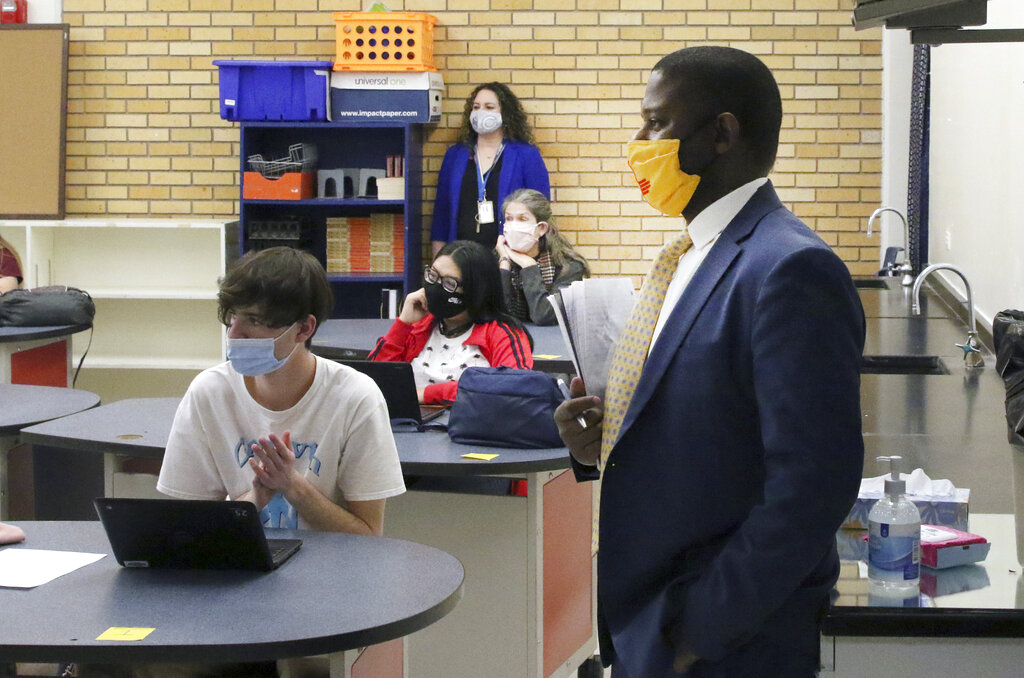
Michael Smith/Carlsbad Current Argus via AP
In this Feb. 9, 2021, file photo, New Mexico Public Education Department Secretary Ryan Stewart visits with students at Carlsbad High School while touring schools to observe hybrid learning in Carlsbad, N.M. New Mexico education officials will send $15 million to 108 of the state’s most impoverished schools as part of a pilot program passed into law earlier this year.
ALBUQUERQUE, N.M. – Recently released data from the Annie E. Casey Foundation shows improvements to New Mexico’s child well-being, but the state remains a tough place to be a kid.
The 2021 national Kids Count Data Book ranks New Mexico 49th in the nation in 16 key child well-being indicators such as child poverty and teen birth rates. The state jumped ahead of Mississippi, which fell to the bottom of the country for overall child well-being.
The Data Book — which collects economic, family and community, education, and health statistics — ranked New Mexico last in child well-being in 2013, 2018, 2019, and 2020.
“I’m cautiously optimistic about the direction we’re heading,” said James Jimenez, executive director of New Mexico Voices for Children, an Albuquerque-based child welfare advocacy organization. “For about a decade up to 2018, we really weren’t seeing much improvement.”
Since 2010, New Mexico has progressed in child poverty rates (17% improvement), health insurance for kids (45%), decreased teen birth rates (55%), and on-time graduation for high school students (32%). A majority of the numbers were collected in 2019 prior to the COVID-19 crisis.
New Mexico remained in the bottom spot in the survey’s education metrics, which also factor measurables including the number of young children who aren’t enrolled in school, reading proficiency for fourth graders, and math proficiency for eighth graders.
“It’s really important for the legislature to continue deliberations over how to address the findings of the Yazzie/Martinez decision in public education,” said Jimenez.
In 2018, a state district court judge ruled in Yazzie/Martinez v. State of New Mexico that the New Mexico Public Education Department and the legislature violated state and federal law by failing to properly educate students of color, economically disadvantaged pupils, and youth with disabilities.
Jimenez also sees encouraging signs with the state’s jump in health care for youth — from 41st in 2020 to 37th in 2021 — but warned that the New Mexico Department of Health and state policymakers need to continue prioritizing health care opportunities for vulnerable youth and families.
The New Mexico Children, Youth and Families Department, led by cabinet secretary Brian Blalock since 2019, is encouraged by New Mexico’s move out of the cellar.
“The department sees this as empirical evidence that focusing our efforts on our strategic plan — informed by the guidance of child welfare experts and youth and families and not political agenda — is the only way we will see meaningful improvement in child well-being in the state,” department spokesperson Charlie Moore-Pabst said.
Massachusetts, New Hampshire, and Minnesota took the top spots for overall child well-being while New Mexico’s neighboring states of Utah (5), Colorado (15), Arizona (40), and Texas (46) saw mixed performances.
The data includes limited amounts of pandemic indicators. As of March 2021, New Mexico fared slightly below the national average for adults in households with children who felt down, depressed, or hopeless and at the national average of 13% for family and youth food insecurity.
The Data Book shows that the state has struggled with children who took fewer classes or canceled post-secondary plans during the coronavirus pandemic, fairing 10 points below the 53% national average. A survey released by Save the Children in March 2021 slotted New Mexico in the nation’s 47th spot for protecting and providing for youth during the upheaval of 2020.
Disclosure: The Annie E. Casey Foundation is a funder of the Center for Sustainable Journalism

























